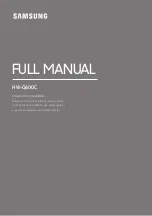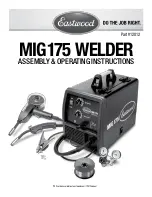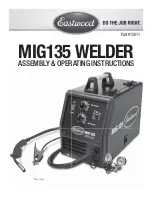
18
4t:
In the 4t operating mode, when the but-
ton is pressed for the first time the protective
gas is released, then when the electrode is
raised from the piece the electric arc is
struck.
The current delivered corresponds to the ini-
tial current parameter as long as the button
is not released, then the machine performs
the ramp-up if set. The next time the button
is pressed the machine performs the ramp-
down of the current, if set, and the final cur-
rent (until the button is released), and then
the post gas phase. If the button is released
immediately the machine performs the ramp-
down of the current (if set) and then the post
gas phase.
4bi:
This operation is similar to the 4t mode
with the only difference that pressing the
torch button for short periods (< 1s) during
welding (after the initial ramp) cause the pas-
sage of the current from the first level I1 to
the second level I2; holding the button down
(> 1s) causes the start of the end of the weld
(ramp-down and/or final current if set).
2nd level current:
If the value 4bi of the 2t-
4t-4bilevel parameter is selected this makes
it possible to set the 2nd level current as a
percentage of the welding current.
Start current:
Used to set the value to which
the welding current is raised immediately
after the electric arc has been struck.
Start time:
Used to set the time for which
the current determined by the initial current
parameter is applied.
In 4t/4bi mode (if the spot weld parameter is
equal to 0) this time has no effect and the ini-
tial current is maintained as long as the torch
button is held down.
Slope up:
Used to set the duration of the
ramp-up of the welding current.
Slope down:
Used to set the duration of the
ramp-down of the welding current.
End current:
Used to set the value which
the welding current reaches at the end of the
ramp-down.
End time:
Used to set the time for which the
current determined by the final current
parameter is applied.
In 4t/4bi mode this time has no effect and the
initial current is maintained as long as the
torch button is held down.
Post gas time:
Used to set the time of gas
delivery after the welding current has
stopped.
Pulse mode:
Used to activate (Hz) or deac-
tivate (OFF) the pulse welding mode; with
the pulse welding mode active (Hz) the
machine delivers the welding current for a
certain time and the current determined by
the base current parameter for another peri-
od of time. The number of current impulses
per unit time is given by the value of the fre-
quency parameter.
The pulsation is activated only during the
welding phase and not during the initial/final
current phases or during the ramps.
Background current:
Used to set the base
current used during generation of the pulses.
Pulse frequency:
Used to set the number of
current impulses per unit time when the
pulse welding mode is active.
Pulse balance:
This represents the per-
centage of time for which the welding current
is applied when the pulse welding mode is
active.
Water pump:
Used to switch on (ON) or
switch off (OFF) the water pump unit if pres-
ent.
Remote:
Used to switch on (ON) or switch
off (OFF) the remote control of the intensity
of the current delivered.
Min current:
Used to set the minimum out-
put current when the remote control is at the
minimum adjustment value.
Spot welding:
Used to set (if other than 0)
the maximum duration of the weld.
Summary of Contents for King 320
Page 2: ......
Page 3: ...KING 320 ...
Page 4: ...TARGA DATI NOMINAL DATA LEISTUNGSCHILDER PLAQUE DONÉES PLACA DE CARACTERÌSTICAS ...
Page 34: ...2 WARNING SYMBOLS ...
Page 35: ...3 ...
Page 36: ...4 ...
Page 62: ...2 VERWENDETE SYMBOLE ...
Page 63: ...3 ...
Page 64: ...4 ...
Page 90: ...2 SYMBOLES UTILISÉS ...
Page 91: ...3 ...
Page 92: ...4 ...
Page 118: ...2 SÌMBOLOS UTILIZADOS ...
Page 119: ...3 ...
Page 120: ...4 ...
Page 145: ...NOTE ...
Page 146: ...NOTE ...
Page 147: ......
Page 148: ......
















































